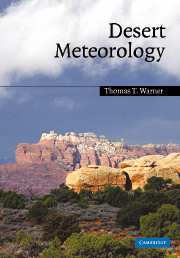Book contents
- Frontmatter
- Contents
- Preface
- Acknowledgements
- 1 Introduction
- 2 The atmospheric dynamics of deserts
- 3 The climates of the world deserts
- 4 Atmospheric and surface energy budgets of deserts
- 5 Surface physics of the unvegetated sandy desert landscape
- 6 Vegetation effects on desert surface physics
- 7 Substrate effects on desert surface physics
- 8 Desert-surface physical properties
- 9 Numerical modeling of desert atmospheres
- 10 Desert boundary layers
- 11 Desert microclimates
- 12 Dynamic interactions among desert microclimates
- 13 Desert rainfall
- 14 Anthropogenic effects on the desert atmosphere
- 15 Changes in desert climate
- 16 Severe weather in the desert
- 17 Effects of deserts on the global environment and other regional environments
- 18 Desertification
- 19 Biometeorology of humans in desert environments
- 20 Optical properties of desert atmospheres
- Appendix A Glossary of meteorological and land-surface terms
- Appendix B Abbreviations
- Appendix C Units, numerical constants, and conversion factors
- Appendix D Symbols
- Appendix E Maps of the world
- Hints to solving some problems and exercises
- References
- Index
- Plate section
- References
3 - The climates of the world deserts
Published online by Cambridge University Press: 04 September 2009
- Frontmatter
- Contents
- Preface
- Acknowledgements
- 1 Introduction
- 2 The atmospheric dynamics of deserts
- 3 The climates of the world deserts
- 4 Atmospheric and surface energy budgets of deserts
- 5 Surface physics of the unvegetated sandy desert landscape
- 6 Vegetation effects on desert surface physics
- 7 Substrate effects on desert surface physics
- 8 Desert-surface physical properties
- 9 Numerical modeling of desert atmospheres
- 10 Desert boundary layers
- 11 Desert microclimates
- 12 Dynamic interactions among desert microclimates
- 13 Desert rainfall
- 14 Anthropogenic effects on the desert atmosphere
- 15 Changes in desert climate
- 16 Severe weather in the desert
- 17 Effects of deserts on the global environment and other regional environments
- 18 Desertification
- 19 Biometeorology of humans in desert environments
- 20 Optical properties of desert atmospheres
- Appendix A Glossary of meteorological and land-surface terms
- Appendix B Abbreviations
- Appendix C Units, numerical constants, and conversion factors
- Appendix D Symbols
- Appendix E Maps of the world
- Hints to solving some problems and exercises
- References
- Index
- Plate section
- References
Summary
It would be well-nigh impossible for one who has heeded the call of the vast Desert solitudes to pass back through the Gateway to the Desert [Tripoli] without a special tribute to the insidious charm of that great land of sand and silence which lies behind it. South, the interminable African main drifts on to the Sudan; west to east it sweeps the whole width of Africa. Even at the Red Sea it merely pauses for a moment at the brink, then dips beneath the limpid waters and continues across Arabia, Persia, and into northern India. …
It is little wonder that the ancients saw in the Sahara, dark dotted with oases, the graphic simile of the leopard's skin. The call of those limitless reaches is as subtle and insidious as must be the snow fields of the Arctic. Listening to it, one is beguiled onward against the gentle pressure of its capricious south-east breezes, under which date-palms nod their graceful crests over the murmoring oases … No sound but the soft scuff of our horses and the creaking saddle leathers breaks the stillness; no shadows except our own paint splashes of azure upon the orange sand. Again, white-walled, bastioned Tripoli lies many miles behind me on the edge of the coast like a great silver shell in a stretch of golden sand, and I feel that somehow I have again drawn back the veil of the ages.
Charles Wellington Furlong, American adventurer and writer The Gateway to the Sahara (1914)- Type
- Chapter
- Information
- Desert Meteorology , pp. 63 - 158Publisher: Cambridge University PressPrint publication year: 2004

